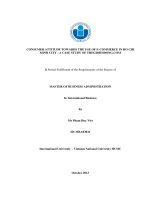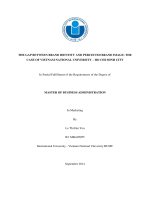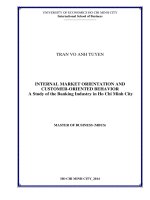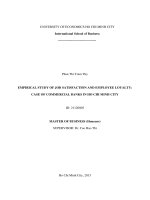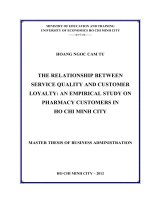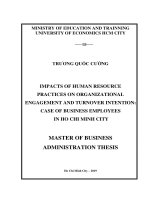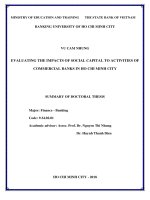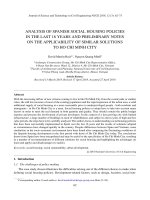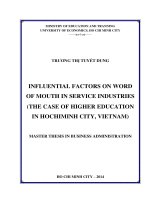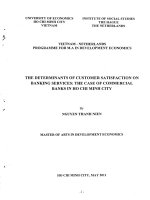The gap between brand identify and perceived brand image the case of vietnam national university ho chi minh city
Bạn đang xem bản rút gọn của tài liệu. Xem và tải ngay bản đầy đủ của tài liệu tại đây (2.11 MB, 106 trang )
THE GAP BETWEEN BRAND IDENTITY AND PERCEIVED BRAND IMAGE: THE
CASE OF VIETNAM NATIONAL UNIVERSITY – HO CHI MINH CITY
In Partial Fulfillment of the Requirements of the Degree of
MASTER OF BUSINESS ADMINISTRATION
In Marketing
By
Le Thi Hai Yen
ID: MBA05055
International University - Vietnam National University HCMC
September 2014
THE GAP BETWEEN BRAND IDENTITY AND PERCEIVED BRAND
IMAGE: THE CASE OF VIETNAM NATIONAL UNIVERSITY – HO CHI
MINH CITY
In Partial Fulfillment of the Requirements of the Degree of
MASTER OF BUSINESS ADMINISTRATION
In Marketing
By
Le Thi Hai Yen
ID: MBA05055
International University - Vietnam National University HCMC
September 2014
Under the guidance and approval of the committee, and approved by all its members,
this thesis has been accepted in partial fulfillment of the requirements for the degree.
Approved:
---------------------------------------------Chairperson
---------------------------------------Committee member
---------------------------------------------Committee member
---------------------------------------Committee member
---------------------------------------------Committee member
---------------------------------------Committee member
-i-
Acknowledge
This thesis cannot be done without the support and encouragement of the
people that I have benefited throughout the time of preparing and completing the
work.
First of all, I would like to express great thank to my advisor, Dr. Nguyen
Minh Ha, who days after days guides me the right way to complete my work. Thanks
to his schedule of responding around 11 p.m. or around 6 a.m., now I form a new
habit for myself - mail checking right after getting up and being ready for work at the
early morning.
I am especially thankful to Dr. Nguyen Quynh Mai, who gave me the very
first and basic knowledge about research. I always remember the days after evening
class discussing with her about research until late even though instructing me is not
her duty.
I also thank to Dr. Pham Hong Hoa for the time working with her in class and
her advice for my postgraduate orientation.
I really want to say thank to academic staff of School Business for their help
arranging my final countdown.
I really appreciate the students who were willing to response for my
questionnaire. Without their contribution, this work cannot complete.
Thanks to my friends, my college with their support so that I can keep chasing
this project.
Last but not least, I own my family, my sister, and my brother a big debt.
Receiving the phone call from my brother after the day of proposal defense, I know
the difficulties and challenges had just begun, but it does not mean I cannot make it.
Le Thi Hai Yen – August 2014
- ii -
Plagiarism Statements
I would like to declare that, apart from the acknowledged references, this
thesis either does not use language, ideas, or other original material from anyone; or
has not been previously submitted to any other educational and research programs or
institutions. I fully understand that any writings in this thesis contradicted to the above
statement will automatically lead to the rejection from the MBA program at the
International University – Vietnam National University Hochiminh City.
- iii -
Copyright Statement
This copy of the thesis has been supplied on condition that anyone who
consults it is understood to recognize that its copyright rests with its author and that
no quotation from the thesis and no information derived from it may be published
without the author‟s prior consent.
© LE Thi Hai Yen/ MBA05055/2013-2014
- iv -
Table of Contents
List of tables .................................................................................................................. ix
List of figures ................................................................................................................. x
Abbreviation ................................................................................................................xii
Abstract .......................................................................................................................xiii
Chapter 1 ........................................................................................................................ 1
INTRODUCTION ......................................................................................................... 1
1.1.
Background .................................................................................................... 1
1.2.
Research objectives ........................................................................................ 2
1.3.
Research questions ......................................................................................... 3
1.4.
Scope and limitation of the study................................................................... 3
1.5.
Research methodology ................................................................................... 4
1.6.
Research significance..................................................................................... 4
1.7.
Research structure .......................................................................................... 5
Chapter 2 ........................................................................................................................ 7
LITERATURE REVIEW .............................................................................................. 7
2.1.
Concept definitions ........................................................................................ 7
2.1.1.
Brand ...................................................................................................... 7
2.1.2.
Brand identity......................................................................................... 8
2.1.2.1.
Brand physique ................................................................................ 10
2.1.2.2.
Brand reputation............................................................................... 10
2.1.2.3.
Brand relevance ............................................................................... 10
-v-
2.1.2.4.
Brand personality ............................................................................. 10
2.1.2.5.
Brand performance........................................................................... 11
2.1.2.6.
Brand relationship ............................................................................ 11
2.1.3.
Brand image ......................................................................................... 11
2.2.
Distinguish between brand identity and brand image .................................. 12
2.3.
The gap existing between brand identity and brand image .......................... 13
2.4.
Previous empirical studies ........................................................................... 15
2.4.1.
Coop‟s (2005) Brand Identity Construct Model .................................. 15
2.4.2.
Ross and Harradine‟s (2011) prism map of brand identity and brand
image
.............................................................................................................. 17
2.4.3.
The differences of this study in comparisons with the previous studies..
.............................................................................................................. 19
Chapter 3 ...................................................................................................................... 21
RESEARCH METHODOLOGY................................................................................. 21
3.1.
Conceptual framework and hypothesis ........................................................ 21
3.1.1. Conceptual framework ............................................................................... 21
3.1.2. Research hypotheses .................................................................................. 23
3.2.
Research design ........................................................................................... 23
3.3.
Target population and sample ...................................................................... 24
3.4.
Data collection methods ............................................................................... 25
3.5.
Measurement ................................................................................................ 26
3.6.
Questionnaire design .................................................................................... 29
3.7.
Survey response rate .................................................................................... 31
3.8.
Data analysis methodology .......................................................................... 33
- vi -
Chapter 4 ...................................................................................................................... 34
DATA ANALYSIS AND EMPIRICAL FINDINGS .................................................. 34
4.1. Descriptive Statistics ......................................................................................... 34
4.1.1. Academic level........................................................................................... 34
4.1.2. Gender ........................................................................................................ 35
4.1.3. City/province.............................................................................................. 36
4.1.4. Awareness of VNU-HCM system ............................................................. 37
4.1.5. Descriptive analysis of six dimensions ...................................................... 39
4.2. Reliability analysis ............................................................................................ 40
4.3. The gap between VNU-HCM brand identity and brand image ........................ 41
4.3.1. Overview of brand identity ........................................................................ 41
4.3.1.1. Brand identity: Brand physique .......................................................... 42
4.3.1.2. Brand identity: Brand reputation ........................................................ 42
4.3.1.3. Brand identity: Brand relevance ......................................................... 43
4.3.1.4. Brand identity: Brand personality ....................................................... 44
4.3.1.5. Brand identity: Brand performance .................................................... 44
4.3.1.6. Brand identity: Brand relationship ...................................................... 45
4.3.2. Overview of brand image........................................................................... 46
4.3.2.1. Brand image: Brand physique ............................................................. 46
4.3.2.2. Brand image: Brand reputation ........................................................... 47
4.3.2.3. Brand image: Brand relevance ............................................................ 48
4.3.2.4. Brand image: Brand personality ......................................................... 49
4.3.2.5. Brand image: Brand performance ....................................................... 50
4.3.2.6. Brand image: Brand relationship ........................................................ 51
4.3.3. Test the significant difference using one-sample t-test.............................. 52
- vii -
4.3.4. Define the gap ............................................................................................ 54
4.3.5. Perceptual mapping the gap ....................................................................... 58
Chapter 5 ...................................................................................................................... 59
CONCLUSION AND RECOMMENDATIONS ........................................................ 59
5.1. Summary ........................................................................................................... 59
5.2. Main findings .................................................................................................... 60
5.2.1. The dimensions to measure VNU-HCM brand identity and brand image. 60
5.2.2. Define the gap between VNU-HCM brand identity and brand image....... 61
5.3. Recommendations ............................................................................................. 62
5.3.1. Three dimensions that VNU-HCM should continue to develop ................ 62
5.3.1.1. Brand relevance .................................................................................. 62
5.3.1.2. Brand physique ................................................................................... 62
5.3.1.3. Brand reputation.................................................................................. 63
5.3.2. Three dimensions that VNU-HCM should for a better image ................... 63
5.3.2.1. Brand performance.............................................................................. 63
5.3.2.2. Brand personality ................................................................................ 63
5.3.2.3. Brand relationship ............................................................................... 63
5.3.3. Suggestion for further study....................................................................... 64
REFERENCE ............................................................................................................... 65
APPENDICES ............................................................................................................. 69
- viii -
List of tables
Table 1: Conceptual definition of brand image ........................................................... 12
Table 2: Distinguish between brand identity and brand image.................................... 13
Table 3: Core brand identity variables and attributes .................................................. 16
Table 4: Core brand identity variables and attributes (Coop, 2004) ............................ 27
Table 5: Survey response rate ...................................................................................... 31
Table 6: Academic level classification ........................................................................ 34
Table 7: Gender frequency and percentage of respondent........................................... 35
Table 8: City and province frequency and percentage................................................. 37
Table 9: Awareness of respondents about VNU-HCM system ................................... 38
Table 10: Descriptive Statistics of six demensions...................................................... 39
Table 11: Reliability test using Cronbach‟s Alpha coefficient .................................... 41
Table 12: VNU-HCM Brand identity score: Brand physique ..................................... 42
Table 13: VNU-HCM Brand identity score: Brand reputation .................................... 43
Table 14: VNU-HCM Brand identity score: Brand relevance..................................... 43
Table 15: VNU-HCM Brand identity score: Brand personality .................................. 44
Table 16: VNU-HCM Brand identity score: Brand performance ................................ 45
Table 17: VNU-HCM Brand identity score: Brand relationship ................................. 45
Table 18: Significant difference testing ....................................................................... 53
Table 19: Respondents' agreement with statements defining VNU-HCM brand image
...................................................................................................................................... 55
Table 20: The gap between VNU-HCM brand identity and brand image (Mean) ...... 58
- ix -
List of figures
Figure 1: Six dimensions of brand identity (Kapferer, 2008) ........................................ 9
Figure 2: Janonis‟s (2007) brand identity and brand image model ............................. 14
Figure 3: Key elements of corporate reputation (Chun, 2005) .................................... 14
Figure 4: Coop‟s (2005) Brand Identity Construct Model........................................... 17
Figure 5: Prism map of Tesco brand identity and brand image (Ross and Harradine,
2011) ............................................................................................................................ 18
Figure 6: Conceptual framework of the gap between brand identity and brand image
...................................................................................................................................... 22
Figure 7: The structure of respondents according to University/Institution ................ 32
Figure 8: Mean of each dimensions – Different perceived brand image between male
and female .................................................................................................................... 36
Figure 9: Mean of the awareness of VNU-HCM system - Differences among
academic levels ............................................................................................................ 38
Figure 10: Percentage of alignment between brand image and brand identity: Brand
physique ....................................................................................................................... 46
Figure 11: Percentage of alignment between brand image and brand identity: Brand
reputation ..................................................................................................................... 47
Figure 12: Percentage of alignment between brand image and brand identity: Brand
relevance ...................................................................................................................... 48
Figure 13: The difference in perceive image of VNU-HCM competitive strength
among academic levels by mean.................................................................................. 49
Figure 14: Percentage of alignment between brand image and brand identity: Brand
personality .................................................................................................................... 50
-x-
Figure 15: Percentage of alignment between brand image and brand identity: Brand
performance ................................................................................................................. 51
Figure 16: Percentage of alignment between brand image and brand identity: Brand
relationship ................................................................................................................... 52
Figure 17: The prism map of the gap between brand identity and brand image ......... 58
- xi -
Abbreviation
ASEAN
: The Association of Southeast Asian Nations
HCMC
: Hochiminh City
IU
: International University
PEFO
: brand performance
PESO
: brand personality
PHY
: brand physique
RELA
: brand relationship
RELE
: brand relevance
REPU
: brand reputation
UEL
: University of Economics & Law
UIT
: University of Information Technology
US
: University of Science
USSH
: University of Social Science & Humanities
UT
: University of Technology
VNU-HCM
: Vietnam National University – Hochiminh City
VN
: Vietnam
- xii -
Abstract
This study aims to define whether there is a possible gap between brand
identity and brand image of VNU-HCM. By calculating the level of alignment
between brand image with brand identity in terms of six dimensions: brand physique,
brand reputation, brand relevance, brand personality, brand performance, brand
relationship, it is revealed that the gap exists.
The study applies the descriptive research methodology with quantitative
approach. The gap between brand identity and brand image then is described by
visualized mapping. The empirical findings of this study indicated that there are
dimensions that VNU-HCM should continue to maintain or develop as well as there
are dimensions that the brand should focus to narrow the gap.
Keywords: brand identity, brand image, brand reputation, brand physique,
brand relevance, brand personality, brand performance, brand relationship
- xiii -
This page is intentionally left blank
- xiv -
Chapter 1
INTRODUCTION
This chapter describes the background of the study including the problem that the brand
Vietnam National University – Hochiminh City (VNU-HCM) is facing. It also discusses
the research objectives, research questions, methodology as well as the significance and
structure of the study.
1.1. Background
Recent years, the higher education sector in Vietnam has become more and more
competitive. Not just public sector supplies higher education service, now private sector
also shows their strength in this field. Almost reputed public universities are now wellknown by the age or the time of their operation instead of their branding efforts. And
while many public universities seems to satisfy with available facilities, infrastructure,
curriculum, staff, and other available conditions, they are lack of branding concentration
which is done quite well by universities in private sector.
Furthermore, after 2010 when Vietnam entered WTO, foreign investors have been
allowed to invest 100% of capital in education sector as well as extension in investment
in international schools and universities (Decree 73/2012/ND-CP on the foreign
cooperation and investment in education). Therefore, the private sector has become more
powerful in supplying higher education service. RMIT (The Royal Melbourne Institute
of Technology University) is a specific example which has been carried out a lot of
- 1-
branding activities. After several years present at Vietnam, this brand name became well
known as the qualified supplier of higher education.
VNU-HCM is the system of universities, institutions and education centers that
cover technology, natural sciences, basic sciences, social and humanity sciences,
literature, foreign languages, medicine and business. Between two biggest universities in
Vietnam, VNU-HCM brand name should be popularized and developed with appropriate
strategies. However, stakeholders seem not to know well about the VNU-HCM rather
than the brand of each member university. The research “The Gap Between Brand
Identity And Perceived Brand Image: The Case of Vietnam National University – Ho
Chi Minh City aims to identify the gap between VNU-HCM brand identity and brand
image as well as give recommendations for strategists of VNU-HCM about brand
positioning in order to leverage the VNU-HCM brand in the competition of higher
education sector in Vietnam and ASEAN.
1.2. Research objectives
The specific objectives of the study are:
-
To find out whether there is a gap between VNU-HCM brand identity and
perceived brand image;
-
To measure the gap between VNU-HCM brand identity and perceived brand
image;
-
To define which attributes should be focused by the brand to narrow the gap;
- 2-
-
Based on the research findings, the study gives recommendations to committee of
VNU-HCM to focus on building brand strategy in the next development period as
well as further studies.
1.3. Research questions
From the problem background, the study raises the below research questions:
-
Which are dimensions to define VNU-HCM brand identity and brand image?
-
Is there any possible gap between the VNU-HCM brand identity and brand
image?
-
How much is the gap between the VNU-HCM brand identity and brand image?
-
What policy implications are proposed to narrow the gap?
1.4. Scope and limitation of the study
In terms of conceptual model, this study will define the possible gap between
brand identity and brand image of VNU-HCM. Due to the fact that brand image is
perceived by customer and it originates from brand identity by the firm. Accordingly, the
brand image is measured through the attributes of brand identity.
In terms of research population, this study considers current students at VNUHCM, alumni of VNU-HCM, staff at VNU-HCM, highschool students (potential
students), parents, and enterprise as its relating stakeholders. However, the respondents
are limited to current students and alumni segment due to the limitation of time and
resources.
- 3-
1.5. Research methodology
The study follows descriptive research design with a quantitative approach. Firstly,
a literature review will be carried out to get an overview of theoretical concepts about
brand identity, brand image. Secondly, the information of branding activities is collected.
Finally, a survey will be conducted with the questionnaire to measure the brand identity
and brand image of VNU-HCM. The study will show the description of VNU-HCM
brand identity and brand image as well as discover the significant attributes that can
enhance the brand development through the finding about the gap between VNU-HCM
brand identity and brand image.
This descriptive research uses convenience nonprobability sample method for
gathering quantitative data. The information is reached directly through questions/answer
questionnaire or indirectly through online questionnaire by email and social media. The
questionnaire is designed with structured questions that require respondents to choose
from a predetermined set of responses.
1.6. Research significance
In terms of academic benefits, the study expects to contribute to the knowledge of
brand identity and brand image in general and the sector of higher education in particular.
In terms of practical finding, this study helps to define the gap between brand
identity and brand image of VNU-HCM brand as well as how well the brand image is
perceived by students. Accordingly, the study aims to give recommendations for
strategists of VNU-HCM about brand positioning in order to leverage the VNU-HCM
brand strength in the competition of higher education sector in Vietnam and ASEAN.
- 4-
1.7. Research structure
This study is divided into five chapters as follow:
Chapter 1 – Introduction - describes the background of the study including the problem
that the brand Vietnam National University – Hochiminh City (VNU-HCM) is facing. It
also discusses the research objectives, research questions, methodology as well as the
significance and structure of the study.
Chapter 2 - Literature Review - presents firstly the concept definitions related to
brand identity and brand image. Then it discusses the difference between brand identity
and brand image as well as the relationship between two constructs. Finally, it reviews
the previous empirical studies about brand identity and brand image.
Chapter 3 – Research Methodology –discusses the conceptual framework as well
as forms the hypotheses of the study. Afterward, the research design, target population
and sampling, data collection methods, measurement, and questionnaire development are
shown.
Chapter 4 – Data Analysis and Findings – presents the quantitative research
analysis. The data are analyzed using the tools including frequencies, percentages, means,
cross-tabulation, Cronbach‟s Alpha reliability coefficient and t-test. Firstly, it focuses on
the descriptive statistics in which the demographic information of respondents is
mentioned. Then the reliability of the measurement and significant difference are tested.
After all, the chapter explores the empirical findings related to the gap of brand identity
and brand image.
- 5-
Chapter 5 – Conclusion & Recommendations – focuses on discussion of empirical
findings. Accordingly, the implication and recommendations are shown. The
recommendation will be given to strategists of VNU-HCM to help leverage the VNUHCM brand in the competition of higher education sector in Vietnam and ASEAN.
- 6-
Chapter 2
LITERATURE REVIEW
This chapter presents firstly the concept definitions related to brand identity and brand
image. Then it discusses the difference between brand identity and brand image as well
as the relationship between two constructs. Finally, it reviews the previous empirical
studies about brand identity and brand image.
2.1.
Concept definitions
2.1.1. Brand
Defined by AMA (American Marketing Asscociation), brand is the "name, term,
design, symbol, or any other feature that identifies one seller's product distinct from those
of other sellers.” However, brand concept is understood somewhat differently and widely
by many authors.
The traditional concept of brand was mention by Kotler (2000) as “… the name,
associated with one or more items in the product line, that is used to identify the source of
character of the item(s)”.
In 2003, Keller further defined that “a brand can be understood as something
more than a product that can help the product to be different to others thanks to a set of
dimension. The differences can be rational and tangible or more symbolic, emotional, and
intangible.
- 7-
2.1.2. Brand identity
According to Aaker (1996), brand identity is created by the brand strategists
through brand associations representing what the brand stands for and considered as a
promise implied by the organization/firm/company. The relationship between the brand
and customer may be generated through a value proposition related to functional,
emotional, or self-expressive benefits. Aaker (1996) described brand identity through
twelve dimensions grouped into four perspectives: brand-as-product (product scope,
product attributes, quality/value, uses, users, country of origin), brand-as-organization
(organizational attributes, local versus global), brand-as-person (brand personality, brandcustomer relationships), and brand-as-symbol (visual imagery/metaphors and brand
heritage).
With a different point of view, Kapferer (1997) shapes the concept of brand
identity through the following questions:
-
What is the aim and individual vision of a brand?
-
What makes a brand distinguished?
-
How satisfaction could be achieved?
-
What is brand‟s equity?
-
What are brand competence, validity and legitimacy?
-
What are the features of its recognition?
The author established the Brand Identity Prism Model in which brand identity
can be defined by six aspects, namely (1) physique, (2) personality, (3) culture, (4)
relationship, (5) reflection, and (6) self-image. Those aspects represents the six facets of
- 8-
the identity prism of the brand. They belongs to two group of dimension which are
constructed source (physique, personality) vs. constructed receiver (reflection, selfimge); and externalisation (physique, relationship, reflection) vs. internalisation
(personaltity, culture, self-image).
Figure 1: Six dimensions of brand identity (Kapferer, 2008)
In 1999, De Chernatony redefined six components to describe brand identity: (1)
brand‟s vision, (2) brand‟s culture, (3) brand‟s positioning, (4) brand‟s personality, (5)
brand‟s relationship, and (6) brand‟s presentation. The author measured those elements of
brand identity and define a gap between brand identity and brand reputation of the firm.
Accordingly, De Chernatony (1999) indicated the gap could be narrowed down by brand
strategics.
- 9-
2.1.2.1.
Brand physique
Brand physique is a set of physique feature of brand and appears in customers‟ mind
whenever the brand name is mentioned (Kapferer, 2003). It is shaped by the most
tangible element of brand identity.
2.1.2.2.
Brand reputation
According to Fombrun and Rindova (1996), brand reputation is described as “a collective
representation of a brand‟s past actions and results that describes the brand‟s ability to
deliver valued outcomes to multiple stakeholders”. Harris and De Chernatony (2001)
further added that brand reputation can be the result from successful management of
internal brand resources.
2.1.2.3.
Brand relevance
Brand relevance can be defined as “how well a brand „speaks‟ to individual audiences.
Therefore, brand should be created to fit with customers‟ needs and desires (Perry and
Wismom, 2003). Consistent with this, Ind (2003) suggested that the values of brand
brought to customers would be relevance to them.
2.1.2.4.
Brand personality
Southgate (1994) indicated that customers tend to be attracted by the brand with
the characteristics like human beings. This concept is related to the personality traits of
the brand, the so-called emotional characteristics (Harris and De Chernatony, 2001).
Consistent with the previous authors, Kapferer (2004) further stated that the
characteristics can be expressed through s specific style of writing, a certain kind of
design features or specific colors schemes.
- 10-
